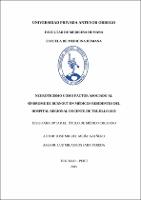| dc.contributor.advisor | Jara Pereda Luz Milagros | |
| dc.contributor.author | Mejia Azañero, Jose Miguel | |
| dc.creator | Mejia Azañero, Jose Miguel | |
| dc.date.accessioned | 2016-12-01T14:11:04Z | |
| dc.date.available | 2016-12-01T14:11:04Z | |
| dc.date.issued | 2016 | |
| dc.identifier | T_MED_1822 | |
| dc.identifier.uri | https://hdl.handle.net/20.500.12759/2194 | |
| dc.description.abstract | La presente investigación buscó determinar al Neuroticismo como
factor asociado al síndrome de Burnout en médicos residentes del Hospital
Regional Docente de Trujillo.
Material y Método: Se realizó un estudio analítico de casos y controles,
incluyéndose a toda la población de médicos residentes (n = 93) de diferentes
especialidades de 1ro al 3er año. El grupo de casos estuvo constituido por sujetos
que presentaron el síndrome de Burnout y el grupo control por los que no lo
presentaron. La variable independiente fue el Neuroticismo (dimensiones). Se
utilizó el cuestionario de Maslasch (SBO) y el Inventario de Personalidad NEO
Revisado (Dimensión Neuroticismo).
Resultados: Se determinó la prevalencia del Síndrome de Burnout (casos) en 54
médicos que cumplieron los criterios de inclusión, con una prevalencia de 50%.
Para la variable Neuroticismo se detectó una prevalencia de 76% que cumplían
los criterios de manifestación. El 100% de médicos residentes con Síndrome de
Burnout, manifestaban Neuroticismo. Se evidenció una relación
estadísticamente significativa entre el Síndrome de Burnout y las dimensiones
del Neuroticismo (X 2 = 17.12, p = 0.0001); existiendo mayor prevalencia en la
especialidad de Ginecología (15%) y durante el primer año de residencia con
52%. Conclusiones: Las dimensiones del Neuroticismo es un factor asociado al
desarrollo de Síndrome de Burnout en Médicos Residentes del Hospital Regional
Docente de Trujillo 2015 | es_PE |
| dc.description.abstract | This research seeks to determine the neuroticism associated factor with
Burnout syndrome in resident physicians of the Regional Hospital of Trujillo.
Material and methods: Control and cases study was performed, universe included
all resident physicians (n = 93) of different specialties of 1st to 3rd year. Case group
was constituted by resident physicians with burnout syndrome and control group
was constitute by resident physicians without burnout. Independent variable was
the Neuroticism (dimensions). Validate instruments use were Maslasch Inventory
for diagnosis of Burnout and Revised NEO Personality Inventory, for neuroticism
dimension.
Results: I estimated the prevalence of burnout in 54 resident physicians that
accepted to answer the inventory test, the gives me a prevalence of 50%.
Neuroticism Variable a prevalence of 76% was detected. The 100% of medical
residents with burnout syndrome, manifested Neuroticism. The Burnout Syndrome
Association and the dimensions of neuroticism are statistically significant (X2 =
17.12, p = 0.0001) and higher prevalence in the specialty of Gynecology (15%) and
during the first year of residency with 52%
Conclusions: The dimensions of Neuroticism is a factor associated with the
development of Burnout Syndrome in resident physicians of the Regional Hospital
of Trujillo 2015. | en_US |
| dc.format | application/pdf | es_PE |
| dc.language.iso | spa | es_PE |
| dc.publisher | Universidad Privada Antenor Orrego | es_PE |
| dc.rights | info:eu-repo/semantics/openAccess | es_PE |
| dc.source | Universidad Privada Antenor Orrego | es_PE |
| dc.source | Repositorio institucional - UPAO | es_PE |
| dc.subject | Síndrome de Burnout | es_PE |
| dc.subject | Neuroticismo | es_PE |
| dc.title | Neuroticismo como factor asociado al síndrome de burnout en médicos residentes del hospital regional docente de Trujillo 2015 | es_PE |
| dc.type | info:eu-repo/semantics/bachelorThesis | es_PE |
| thesis.degree.level | Título Profesional | es_PE |
| thesis.degree.grantor | Universidad Privada Antenor Orrego. Facultad de Medicina Humana | es_PE |
| thesis.degree.name | Médico Cirujano | es_PE |
| thesis.degree.discipline | Medicina | es_PE |

